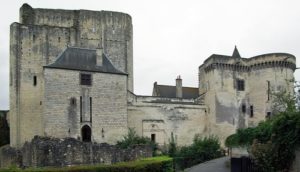The massive Donjon dominates the view of Loches from the south.
It was built round the monastery founded in 5thC by St. Ours and predates the Logis Royal.
Built by Foulques Nerra, 4th Count of Anjou in the 11C it is one of the oldest surviving keeps and was a major stronghold of Foulques Nerra during his war with the house of Blois. It was a source of conflict between the Kings of England and France. In 1193, John Lackland yielded it to Philippe Auguste. It was later regained by Richard I after a siege lasting three hours (if the legend is to be believed). In 1205, Philippe Auguste reconquered fortress after a year long siege. Since then it has remained in the hands of the French crown and administered and run by the royal governors. It served as a military fortress until the mid 15thC. Louis XI converted it into a state prison and it remained a house of detention and correction until 1926.
There have been alterations and additions since it was built and it is quite a difficult site to understand. In the centre is the huge square keep of Foulkes Nerra. This is surrounded by a 12thC protective rampart with 13thC oval towers which were added to reduce blind spots along the wall. The 15thC Martelet Tower housed political prisoners. A barbican was added in the 15thC to protect the entrance against artillery assaults. Later buildings inside the walls include the Louis XI tower and the Governor’s Residence.
A modern wooden staircase lead up into the main entrance of the fortress. This had been protected by a triangular barbican, now a rubble strewn area and best seen looking down from the top of the keep.
The ticket office and a small shop are in the 14thC Governor’s Residence. Entry is €7 which also includes the Logis Royale. (Buying a ticket in advance from the Tourist Office saves €1.)
Steps and passageways lead from this into Louis IX tower. This was built in the 15thC and was probably intended to replace the 11thC keep against the new threat of artillery and to complete the fortifications at the point where three walls meet – the keep wall, the castle wall and the town wall. Cannons were placed on the flat roof which has a wall round it with machicolations.
Inside, steps lead down into what is described as a dungeon; a large barrel shaped room which was more likely a cellar. The torture chamber has two long metal bars with rings to hold the legs. Another room has a model of the buildings when in use with information.
Upstairs is the Graffiti Room which is covered by carvings made by prisoners in the soft stone of the walls. These are full sized humans who would have been 5’6’’ tall and wore size 8 shoes. On either side of the door are two doormen. There is a duelling scene on one wall with duellists holding a dagger and sword. Between them is a ‘referee’. There are other figures also holding weapons. All are dressed in doublet, hose and have shoes and hats. On one wall is a crucifixion scene carved in 5 steps.
The Martlelet Tower is a small tower attached to the defensive wall. It was built in the 15thC to hold political prisoners. Ludovicio Sforza, Duke of Milan was imprisoned here for 4 years. He had a passion for the arts and decorated the walls of his cell with paintings. There is only entry into the ground floor as the upper floors are now shut to help preserve the paintings. Steps lead down into a network of 11thC underground passageways, formed when tufa was quarried to build the keep. One of these passageways is open and leads into the lower rampart. It has been suggested that the tunnels could have been used in the Middle Ages to provide access to the outside of the fortress in times of siege.
The Donjon or keep is huge and at 36m high, dominates the site. The walls are 3.5m thick at the base. As a defensive structure there were few windows. No internal structures are left but narrow stone steps lead up the inside of the walls.
The ground floor was used as a store and armoury. A well is in the south-east comer. On the first floor was the Great Hall. Counsellors and close family members met on the second floor and there was access to the chapel from here. The third floor was the private family quarters. There is access to the top of the Donjon which has excellent views of the site and of Loches.
Inside the base of the keep is a reconstruction of the iron cage (wood and iron) similar to that which imprisoned Philippe de Commynes, chronicler to Louis XI. According to his memoirs, he spent eight months locked in an iron cage. It is made of wood on the outside with bands of iron. It is about 2m square and boarded top and bottom. A slit allowed food and drink to be passed in. At the bottom of the door was space for a large iron chamber pot.
Link this in with a visit to the Logis Royal and St Ours Church.
Anyone with walking difficulties will find this a difficult site to negotiate as there are a lot of steps.








